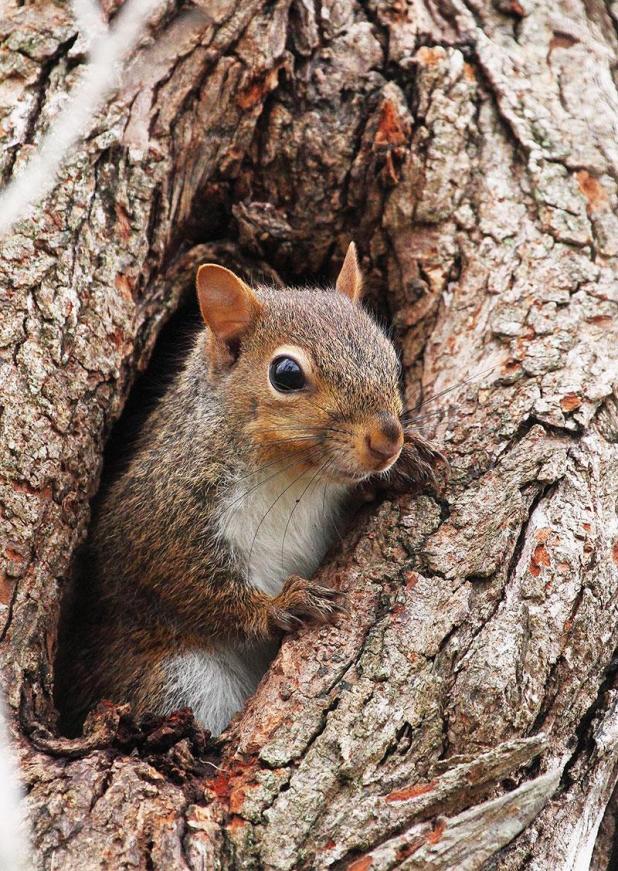
Squirrels are abundant on state and federal public lands
(Submitted Photo/Courtesy of John K. Flores)
Plenty of opportunity statewide for small-game hunting
Hey out there! Can you hear me? Does anyone hunt squirrels and rabbits anymore? For the life of me, I don’t know why these critters now are taking a back seat to all other hunting?
There was a time whenm a kid’s first introduction to hunting was sitting with his pawpaw underneath an oak or wild pecan tree just before sunrise waiting for squirrels to arrive. Sadly, today kids that hunt pretty much go from being potty-trained to sitting in a shooting house overlooking deer feeders.
Nonetheless, from a fore-cast standpoint there may not be a more under-utilized, more abundant hunting resource, than small game in the form of rabbits and squirrels.
The most recent population status survey I could find on the Louisiana Department of Wildlife and Fisheries Website was compiled from the 2012-2013 season. According to the survey 22,100 rabbit hunters harvested 180,100 rabbits. That same report indicated 50,700 squirrel hunters harvested 872,100 squirrels.
By contrast, the most re-cent data compiled concern-ing the waterfowl program on the LDWF website was from 2001. At that time some 1.8 million hunters took to the field and marshes to hunt ducks and geese according to the report. This number was derived from hunters 16 years of age and older.
If my math is correct, there were 81 times more waterfowl hunters than rabbit hunters and 35 times more than squirrel hunters.
Oddly enough, unlike wa-terfowl and deer hunting, there is tremendous oppor-tunity to hunt small game on public land. Nearly every state wildlife management area allows rabbit and squir-rel hunting.
All one has to do, is go to the LDWF website, scroll over to public areas and facilities, and click on wildlife management areas. There is an interactive map where you can highlight the particular WMA you’re interested in. All you have to do next is locate it on the alphabetized list to find everything you wanted to know about the area – including if rabbit and squirrel hunting is allowed.
Additionally, there are 23 National Wildlife Refuges scattered across the state north, south, east and west, many which allow small game hunting. By doing a web search you can go to www.fws.gov/refuges/refugelocatormaps/louisiana.html where you’ll find a refuge locator map. Once you’ve located the refuge you’re interested in, you can do an additional web search to review its particular hunting regulations.
Bayou Teche National Wildlife Refuge in St. Mary Parish is a 9028-acre refuge located in the coastal towns of Franklin, Garden City, and Centerville. This particular NWR allows both rabbit and squirrel hunting.
Perhaps there is no greater opportunity to hunt small game than on Kisatchie National Forest. Kisatchie is massive, spanning some 604,000 acres in five ranger units (Evangeline, Vernon, Caney Lake, Middle Fork Unit, and Corney Lake).
I floated the Dugdemona River through the Kisatchie forest a number of years ago hunting both squirrel and wood ducks. The pine trees along the river looked like they touched the sky. And, the squirrels were abundant.
I did this trip just prior to Christmas, when the leaves were pretty much off the trees. Around each bend, squirrels were foraging along the banks of the Dugdemona. The challenge was getting off a shot from a sitting position while the canoe drifted with the current.
There was also the chal-lenge of how fast these critters could get up the side of the trees. My shots were quite often 30 to 40 yards up, by the time I squeezed the trigger. I quickly learned, Kisatchie is a place where you’ll want to use high brass number 6 shot when trying to shoot a mess of squirrels.
The thing about hunting squirrels north of I-10 in the upland piney woods, bottom-land hardwood swamps along the tributaries of Mississippi and agricultural woodlots is the abundance of mast crop. Even some of the worst years produce more acorns and wild pecans than necessary to sustain Louisi-ana’s thriving population of tree- rats.
It’s the same with the coastal parishes where there are abundant populations of gray squirrels in the marsh. Squirrels are omnivorous. Besides mast, they eat berries, buds, and even bird eggs. Barring any tropical events, coastal squirrels do quite well. What’s more, there’s nothing quite like paddling a pirogue along a canal bank in the marsh on a cool October or November morning, while quietly sneaking up on squirrels feeding in the hackberry and myrtle trees.
Rabbit hunting in the coastal marsh most years is nothing short of legendary. Following the waterfowl season is when things usually get cranked up on the Atchafalaya Delta WMA.
Many waterfowl hunters who have moored camps on the refuge take full ad-vantage of the sheer abun-dance of swamp rabbits and extend their winter stay well into late Februray. What’s more, it’s one of those best kept secrets they tell few about – other than close friends and family.
2018 has been quiet, where tropical storms are concerned for our area. Moreover, there has been plenty of sunshine and rainfall to promote an adequate supply of food resources for small game. The question is, will you take the time to go out and chase a few rabbits and squirrels this fall?
